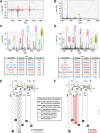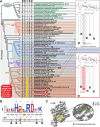Structural determination of Rickettsia lipid A without chemical extraction confirms shorter acyl chains in later-evolving spotted fever group pathogens
- PMID: 38259062
- PMCID: PMC10900879
- DOI: 10.1128/msphere.00609-23
Structural determination of Rickettsia lipid A without chemical extraction confirms shorter acyl chains in later-evolving spotted fever group pathogens
Abstract
Rickettsiae are Gram-negative obligate intracellular parasites of numerous eukaryotes. Human pathogens of the transitional group (TRG), typhus group (TG), and spotted fever group (SFG) rickettsiae infect blood-feeding arthropods, have dissimilar clinical manifestations, and possess unique genomic and morphological attributes. Lacking glycolysis, rickettsiae pilfer numerous metabolites from the host cytosol to synthesize peptidoglycan and lipopolysaccharide (LPS). For LPS, O-antigen immunogenicity varies between SFG and TG pathogens; however, lipid A proinflammatory potential is unknown. We previously demonstrated that Rickettsia akari (TRG), Rickettsia typhi (TG), and Rickettsia montanensis (SFG) produce lipid A with long 2' secondary acyl chains (C16 or C18) compared to short 2' secondary acyl chains (C12) in Rickettsia rickettsii (SFG) lipid A. To further probe this structural heterogeneity and estimate a time point when shorter 2' secondary acyl chains originated, we generated lipid A structures for two additional SFG rickettsiae (Rickettsia rhipicephali and Rickettsia parkeri) utilizing fast lipid analysis technique adopted for use with tandem mass spectrometry (FLATn). FLATn allowed analysis of lipid A structure directly from host cell-purified bacteria, providing a substantial improvement over lipid A chemical extraction. FLATn-derived structures indicate SFG rickettsiae diverging after R. rhipicephali evolved shorter 2' secondary acyl chains. While 2' secondary acyl chain lengths do not distinguish Rickettsia pathogens from non-pathogens, in silico analyses of Rickettsia LpxL late acyltransferases revealed discrete active sites and hydrocarbon rulers for long versus short 2' secondary acyl chain addition. Our collective data warrant determining Rickettsia lipid A inflammatory potential and how structural heterogeneity impacts lipid A-host receptor interactions.IMPORTANCEDeforestation, urbanization, and homelessness lead to spikes in Rickettsioses. Vector-borne human pathogens of transitional group (TRG), typhus group (TG), and spotted fever group (SFG) rickettsiae differ by clinical manifestations, immunopathology, genome composition, and morphology. We previously showed that lipid A (or endotoxin), the membrane anchor of Gram-negative bacterial lipopolysaccharide (LPS), structurally differs in Rickettsia rickettsii (later-evolving SFG) relative to Rickettsia montanensis (basal SFG), Rickettsia typhi (TG), and Rickettsia akari (TRG). As lipid A structure influences recognition potential in vertebrate LPS sensors, further assessment of Rickettsia lipid A structural heterogeneity is needed. Here, we sidestepped the difficulty of ex vivo lipid A chemical extraction by utilizing fast lipid analysis technique adopted for use with tandem mass spectrometry, a new procedure for generating lipid A structures directly from host cell-purified bacteria. These data confirm that later-evolving SFG pathogens synthesize structurally distinct lipid A. Our findings impact interpreting immune responses to different Rickettsia pathogens and utilizing lipid A adjuvant or anti-inflammatory properties in vaccinology.
Keywords: FLATn; Rickettsia; Rocky Mountain spotted fever; evolution; lipid A; lipopolysaccharide; pathogenesis; rickettsiosis; spotted fever group.
Conflict of interest statement
The authors declare no conflict of interest.
Figures


Update of
-
Structural determination of Rickettsia lipid A without chemical extraction confirms shorter acyl chains in later-evolving Spotted Fever Group pathogens.bioRxiv [Preprint]. 2023 Jul 6:2023.07.06.547954. doi: 10.1101/2023.07.06.547954. bioRxiv. 2023. Update in: mSphere. 2024 Feb 28;9(2):e0060923. doi: 10.1128/msphere.00609-23. PMID: 37461656 Free PMC article. Updated. Preprint.
Similar articles
-
Structural determination of Rickettsia lipid A without chemical extraction confirms shorter acyl chains in later-evolving Spotted Fever Group pathogens.bioRxiv [Preprint]. 2023 Jul 6:2023.07.06.547954. doi: 10.1101/2023.07.06.547954. bioRxiv. 2023. Update in: mSphere. 2024 Feb 28;9(2):e0060923. doi: 10.1128/msphere.00609-23. PMID: 37461656 Free PMC article. Updated. Preprint.
-
Lipid A Structural Divergence in Rickettsia Pathogens.mSphere. 2021 May 5;6(3):e00184-21. doi: 10.1128/mSphere.00184-21. mSphere. 2021. PMID: 33952661 Free PMC article.
-
Rickettsia Lipid A Biosynthesis Utilizes the Late Acyltransferase LpxJ for Secondary Fatty Acid Addition.J Bacteriol. 2018 Sep 10;200(19):e00334-18. doi: 10.1128/JB.00334-18. Print 2018 Oct 1. J Bacteriol. 2018. PMID: 30012728 Free PMC article.
-
Rickettsioses of the spotted fever group around the world.J Dermatol. 1989 Jun;16(3):169-77. doi: 10.1111/j.1346-8138.1989.tb01244.x. J Dermatol. 1989. PMID: 2677080 Review.
-
Rickettsiae.In: Baron S, editor. Medical Microbiology. 4th edition. Galveston (TX): University of Texas Medical Branch at Galveston; 1996. Chapter 38. In: Baron S, editor. Medical Microbiology. 4th edition. Galveston (TX): University of Texas Medical Branch at Galveston; 1996. Chapter 38. PMID: 21413251 Free Books & Documents. Review.
Cited by
-
A critical role for Vibrio parahaemolyticus LPS to mediate evasion of host immune response during infection.Proc Natl Acad Sci U S A. 2025 Aug 19;122(33):e2426547122. doi: 10.1073/pnas.2426547122. Epub 2025 Aug 13. Proc Natl Acad Sci U S A. 2025. PMID: 40802686 Free PMC article.
-
Pathogenic Rickettsia spp. as emerging models for bacterial biology.J Bacteriol. 2024 Feb 22;206(2):e0040423. doi: 10.1128/jb.00404-23. Epub 2024 Feb 5. J Bacteriol. 2024. PMID: 38315013 Free PMC article. Review.
-
Polysaccharide synthesis operon modulates Rickettsia-endothelial cell interactions.PLoS Pathog. 2025 Jun 26;21(6):e1013277. doi: 10.1371/journal.ppat.1013277. eCollection 2025 Jun. PLoS Pathog. 2025. PMID: 40570043 Free PMC article.
References
-
- Davison HR, Pilgrim J, Wybouw N, Parker J, Pirro S, Hunter-Barnett S, Campbell PM, Blow F, Darby AC, Hurst GDD, Siozios S. 2022. Genomic diversity across the Rickettsia and ‘candidatus megaira’ genera and proposal of genus status for the torix group. Nat Commun 13:2630. doi:10.1038/s41467-022-30385-6 - DOI - PMC - PubMed
-
- Driscoll TP, Verhoeve VI, Guillotte ML, Lehman SS, Rennoll SA, Beier-Sexton M, Rahman MS, Azad AF, Gillespie JJ, Rikihisa Y. 2017. Wholly Rickettsia ! reconstructed metabolic profile of the quintessential bacterial parasite of eukaryotic cells. mBio 8:e00859-17. doi:10.1128/mBio.00859-17 - DOI - PMC - PubMed
MeSH terms
Substances
Supplementary concepts
Grants and funding
LinkOut - more resources
Full Text Sources
Research Materials
Miscellaneous
